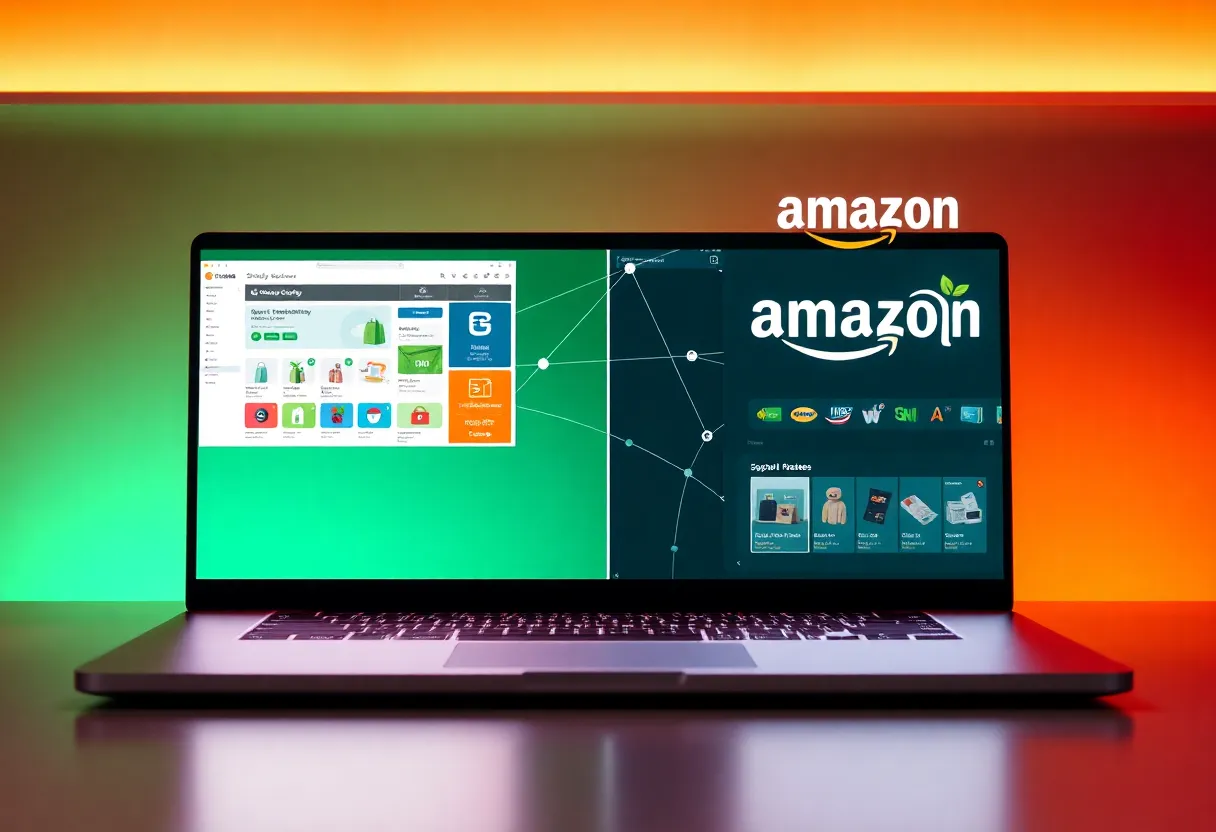Table of Contents
The E-commerce Landscape
Online shopping has exploded in recent years, with global e-commerce sales hitting $5.2 trillion in 2021. This surge has led more businesses to embrace multi-channel selling strategies to reach customers wherever they shop.
Amazon stands out as a giant in this landscape. With over 300 million active customers worldwide, it’s a marketplace many sellers can’t afford to ignore. But tapping into Amazon’s massive audience comes with challenges.
Here’s a quick look at why Amazon matters for e-commerce businesses:
- 45% of US e-commerce market share
- 2.5 billion monthly website visits
- 9.7 million third-party sellers globally
- $470 billion in net sales (2021)
Managing inventory and orders across multiple sales channels can quickly become a logistical nightmare. Many sellers struggle to keep product listings, stock levels, and order fulfillment in sync across platforms.
This is where tools like Marketplace Connect come in handy. They help streamline operations by automating tasks like inventory updates and order syncing between Shopify and marketplaces like Amazon.
Let’s take a closer look at how sellers can leverage Shopify to simplify creating and managing Amazon listings:
This video walks through how Marketplace Connect integrates Shopify stores with Amazon and other major marketplaces, showing how it can save time and reduce errors in multi-channel selling.
As e-commerce continues to grow, efficiently managing multiple sales channels will be key for businesses looking to scale. Tools that simplify creating Amazon listings via Shopify can give sellers a competitive edge in this increasingly complex landscape.
Setting Up Your Shopify-Amazon Connection
Getting your Shopify store connected to Amazon can seem tricky, but it’s actually pretty straightforward. First things first, you’ll need active accounts on both platforms. Make sure your Shopify store is up and running, and you’ve got an Amazon seller account ready to go.
Once you’ve got those basics covered, it’s time to link them up. Here’s a quick rundown of what you’ll need to do:
- Install an integration app like Marketplace Connect from the Shopify app store
- Connect your Amazon account by following the app’s setup wizard
- Choose which products you want to list on Amazon
Setting up the right configurations is key to making sure everything runs smoothly. You’ll want to pay attention to things like pricing rules and inventory sync settings. These help keep your Shopify and Amazon stores in sync, so you don’t accidentally oversell or underprice your products.
Creating Amazon Listings from Shopify
Now that you’re all set up, let’s talk about creating those Amazon listings right from your Shopify dashboard. It’s a game-changer for streamlining your workflow. Instead of jumping back and forth between platforms, you can manage everything in one place.
Here’s the basic process for creating a new Amazon listing:
- Navigate to your products in Shopify
- Select the item you want to list on Amazon
- Click on “Create listing” in your integration app
- Fill in any additional details Amazon requires
- Submit your listing for approval
When you’re creating your listings, remember that Amazon has its own set of best practices. Here are some tips to help your products stand out:
- Use high-quality images that show your product from multiple angles
- Write clear, detailed product descriptions
- Include relevant keywords in your title and bullet points
- Price competitively, but don’t undervalue your products
By following these guidelines, you’ll be setting yourself up for success on Amazon’s marketplace.
Automating Inventory and Order Sync
One of the biggest headaches in multi-channel selling is keeping everything in sync. That’s where automation comes in handy. With the right tools, you can set up real-time inventory updates and order synchronization between Shopify and Amazon.
Let’s break down some of the key features you’ll want to look for:
| Feature | Benefit |
|---|---|
| Real-time inventory sync | Prevents overselling across platforms |
| Automated order import | Centralizes order management in Shopify |
| Price sync | Ensures consistent pricing across channels |
Tools like Marketplace Connect offer these features and more. They can help you automate the tedious parts of multi-channel selling, freeing up your time to focus on growing your business.
Setting up automation might take a bit of time upfront, but it pays off in the long run. You’ll spend less time on manual data entry and more time on strategy and customer service.
This video walks you through the process of setting up Shopify with Amazon, including some tips on automated fulfillment. It’s a great visual guide to complement the steps we’ve covered.
Remember, the key to successful multi-channel selling is efficiency. By streamlining your listing process and automating as much as possible, you’ll be well on your way to scaling your e-commerce business across both Shopify and Amazon. And with tools like Marketplace Connect, you can manage it all without breaking a sweat.
Maximizing Your Multi-Channel Strategy
Integrating Shopify with Amazon opens up a world of possibilities for e-commerce businesses. Let’s break down the key advantages:
- Expanded customer base
- Streamlined operations
- Improved inventory management
- Enhanced brand visibility
By leveraging both platforms, sellers can tap into Amazon’s massive user base while maintaining the flexibility of their Shopify store. This dual presence significantly boosts sales potential and market reach.
Automation is the secret sauce here. With tools like Marketplace Connect, businesses can save countless hours on manual data entry and order processing. This frees up valuable time to focus on growth strategies and customer service.
Pro tip: Use the time saved from automation to improve your product listings and customer engagement.
Let’s look at the potential impact on a typical e-commerce business:
| Metric | Before Integration | After Integration |
|---|---|---|
| Sales Channels | 1 (Shopify) | 2+ (Shopify + Amazon) |
| Daily Orders | 20 | 35-50 |
| Time Spent on Order Processing | 2 hours | 30 minutes |
The numbers speak for themselves. Multi-channel selling, when done right, can supercharge your business growth.
But it’s not just about more sales. The unified analytics provided by integration tools offer invaluable insights. You can track performance across platforms, identify top-selling products, and make data-driven decisions to optimize your inventory and marketing strategies.
- Monitor cross-platform performance
- Identify bestsellers and trends
- Adjust pricing and inventory in real-time
- Tailor marketing efforts based on channel-specific data
By harnessing the power of both Shopify and Amazon, businesses can create a robust, scalable e-commerce ecosystem. The key is finding the right tools to make this integration seamless and efficient.
Remember: A well-executed multi-channel strategy is more than the sum of its parts.
Wrap-up
Creating Amazon listings through Shopify can really streamline your business operations. It saves time, reduces errors, and helps you reach more customers. But it’s not always a walk in the park.
That’s where tools like Marketplace Connect come in handy. They take care of the nitty-gritty details, so you can focus on growing your business. With features like real-time inventory updates and order syncing, you’re less likely to oversell or miss an order.
Remember, success in e-commerce often comes down to efficiency. The less time you spend on manual tasks, the more you can dedicate to strategy and customer service. So why not give it a shot? Your future self might thank you for making the leap.
Next up, we’ll tackle some common questions about creating Amazon listings via Shopify. Stay tuned for practical tips and insights that could make your multi-channel selling journey a whole lot smoother.
Common Questions About Shopify-Amazon Integration
How do I start creating Amazon listings from Shopify?
To create Amazon listings from Shopify, you’ll need to connect your Shopify store to Amazon using an integration app. Our Marketplace Connect app simplifies this process, allowing you to sync products, manage orders, and update inventory across both platforms seamlessly. Once connected, you can create new Amazon listings directly from your Shopify admin panel.
What are the benefits of creating Amazon listings via Shopify?
Creating Amazon listings through Shopify offers several advantages:
- Centralized inventory management
- Simplified order processing
- Time savings on manual data entry
- Reduced risk of overselling
- Consistent product information across channels
These benefits help streamline your operations and improve overall efficiency.
Are there any additional fees for selling on Amazon through Shopify?
While Shopify doesn’t charge extra fees for Amazon integration, you’ll still need to pay Amazon’s standard selling fees. These include referral fees, fulfillment fees (if using FBA), and potentially monthly subscription fees depending on your seller plan. It’s important to factor these costs into your pricing strategy.
Can I sync all my Shopify products to Amazon automatically?
Most integration apps, including Marketplace Connect, allow bulk product syncing. However, it’s often best to review and optimize each listing before publishing on Amazon. This ensures your products meet Amazon’s requirements and are positioned competitively in the marketplace.
What should I do if my Amazon listings aren’t syncing properly?
If you’re experiencing syncing issues, first check your integration settings and ensure all connections are active. Verify that your products meet Amazon’s listing requirements. If problems persist, reach out to your integration app’s support team. For users of Marketplace Connect, our dedicated support staff is always ready to help troubleshoot and resolve any syncing issues.
How does Marketplace Connect help with Amazon-Shopify integration?
Marketplace Connect streamlines the entire process of selling on Amazon through Shopify. It offers features like automated order syncing, real-time inventory updates, and simplified listing creation. This saves time, reduces errors, and helps you manage your multi-channel business more effectively. You can learn more and start a free trial at our Shopify app page.





